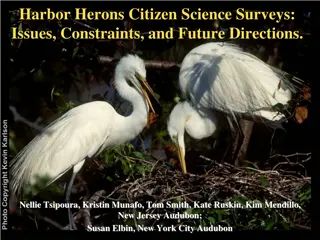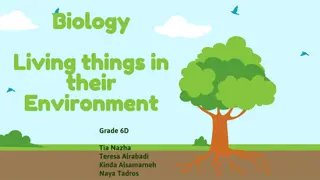Overview of Asteraceae Family: Characteristics and Habitat
Asteraceae, also known as Compositae, is one of the largest families of flowering plants with around 13,000 species. They show diverse characteristics such as herbaceous or woody stems, simple leaves, and distinctive inflorescence types like racemose heads. This family is widely distributed globally, with notable representation in the Himalayas and mountains of India. Asteraceae includes both mesophytes and xerophytes, with a range of habitat preferences.
Download Presentation

Please find below an Image/Link to download the presentation.
The content on the website is provided AS IS for your information and personal use only. It may not be sold, licensed, or shared on other websites without obtaining consent from the author. Download presentation by click this link. If you encounter any issues during the download, it is possible that the publisher has removed the file from their server.
E N D
Presentation Transcript
Asteraceae: Asteraceae is also known as Compositae. It is one of the largest families of flowering plants. This family includes 900 genera and about 13,000 species. These form more than ten per cent of the total number of species of flowering plants. Distribution: The members of this family are distributed throughout the world. They inhabit every conceivable situation. In India this family is represented by about 138 genera and 708 species. The members of this family are found chiefly in Himalayas and mountains of southern and western India. Habitat: Members of this family are mostly mesophytes and some xerophytes are also known in this family. Habit: Mostly annual or perennial herbs, rarely shrubs (Helianthus annus) and trees (Veronia). Occasionally marsh plants (Caesulia) also occur in this family. Root system: Generally the root system is branched taproot system. Tuberous are present in Dhalia.The roots and stem may contain oil passages. Stem: Herbaceous or woody, erect, branched. Helianthus tuberoses produces stem tubers. Many species have milky white sap. Stems are often covered by trichomes.
Leaf: Leaves are simple, alternate or opposite (Helianthus) or whorled (Eupatorium), exstipulate, petiolate, hairy, reticulate venation. They are simple or pinnately or palmately lobed. In Corymbium the leaves are parallel veined. Sometimes leaves are present in basal rosettes as in Taraxacum.
Inflorescence: The primary inflorescence is a racemose head or capitulum. It is terminal or axillary in position. In some species several heads aggregate to form compound head or umble or panicle. Each head is subtended by an involucre of green membranous bracts which are protective in function. The flowers of this inflorescence are called florets. Number of florets in the head varies from few to many. Sometimes only single florets are present as in Echinopus. The flowers are open in acropetal succession. The florets are borne on a flat, concave or convex receptacle. Each floret is subtended by a receptacular bract called palea. Flower: Flowers are bracteates, sessile, bisexual (sometimes unisexual or neutral), pentamerous, epigynous. The form of flowers may vary in head and the head may be homogamous or heterogamous. Homogamous: All the florets are alike in structure and function. They are bisexual and either regular (Veronica) or liguate (Cichorium). Heterogamous: Florets in heterogamous heads are of two types described below
Disc florets They are centripetally arranged complete florets. The florets are bracteate, actinomorphic and bisexual, tubular and epigynous. They do not possess any extra-appendage. So, this floret is illinguate Calyx: Absent or modified into pappus Corolla: Sepals 5 in number, Gamosepalous, tubular Androecium: Stamens 2, epipetalous, syngenesious dithecous Gynoecium: Bicarpellary, Syncarpous, unilocular, one ovule, on basal placentation style single, stigma bifid Ray florets They are peripherally placed incomplete florets. The florets are zygomorphic and unisexual or neutral. This helps in increasing the attraction of the flower. They possess extra appendages called ligule. So, this floret is ligulated. Calyx:Absent or hairy pappus or scaly persistent Corolla: Petals 5 in number, polypetalous, ligulate Androecium:Absent Gynoecium: Bicarpellary, syncarpous, unilocular, one ovule, the locule, basal placentation, style narrow and stigma branched, ovary inferior
Fruit: The fruit is a Cypsela which is dispersed by pappus hairs (Taraxacum). In Xanthium the fruits are dispersed by animals due to presence of hooks. Seed: Non-endospermic with straight embryo.
Orchidaceae Perennial herbs, epiphytes or saprophytes may be terrestrial; flowers zygomorphic, hermaphrodite, epigynous. Habit: Perennial terrestrial, succulent, scapose herbs; many are epiphytic or saprophytic, sometimes climbers Vanilla. Root: Adventitious, tuberous, (Orchis), fleshy, climbing or aerial. Main roots always absent. Stem: Erect, sometimes climbing or trailing, annual in terrestrial forms, perennial in epiphytic forms; generally thickened into rhizome or pseudobulbs (Phajus, Bulbophyllum), bearing aerial assimilatory roots. (Taeniophyllum). Leaf: Simple, alternate, sometimes opposite or whorled, usually fleshy, linear to ovate, sheathing base, sometimes reduced to achlorophyllous scales.
Inflorescence: Solitary or spike, racemes or panicle Flower: Flowers are of variable and peculiar, shape, size and colour, often showy, bracteate, zygororphic, bisexual or rarely unisexual, eipgynous, trimerous, mostly resupinate i.e. twisted to 180 or upside down. Perianth: Tepals 6, in two whorls of each, outer 3 tapals (representing calyx) green; inner 3 tepals coloured (representing corolla), dissimilar-the 2 lateral or wings like, the third posterior tepals is lightly modified often projected basally the labellum or lip; broad, shoe-like spursed, tubular, strap-shaped or butterfly shaped or variously branched and contributing most to the oddity and beauty of the flower. Androecium: Stamens 3, which unite with the pistil to form a column, the gynandrium or gynostemium opposite to the labellum; functional stamen (Orchis) or 2 (Cypripedium), bithecous, introrse; pollen granular or coherent in each cell into one, 2 or 4 stalked pollen masses or pollinia.
Gynoecium: Tricarpellary, syncarpous, ovary inferior, unilocular, parietal placentation, rarely trilocular and axile placentation (Apostasia); stigmas 3, of which 2 lateral are often fertile, the third stigma is sterile forming a small beaked outgrowth the rostellum lying in the centre of column between the anther and fertile stigma. In Cypripedium and Paphiopedium, all the 3 stigmas are functional. Fruit: A capsule. Seed: Small, light (0.004 gm. each), non-endospermic.
Poaceae (Gramineae) : Grass Family Habit: Herbs, annuals or perennials or shrubs, sometimes tree like (Bambusa, Dendrocalamus). Root: Adventitious, fibrous, branched, fascicled or stilt (Zea mays). Stem: Underground rhizome in all perennial grasses, cylindrical, culm with conspicuous nodes and internodes, internodes hollow, herbaceous or woody, glabrous or glaucous, vegetative shoots are arising from the base of aerial stem or from underground stems are called tillers. Leaves: Alternate, simple, distichous, exstipulate, sessile, ligulate (absent in Echinochloa), leaf base forming tubular sheath, sheath open, surrounding internode incompletely, ligule is present at the junction of the lamina and sheath, entire, hairy or rough, linear, parallel venation.
Inflorescence: Compound spike which may be sessile or stalked. Each unit of inflorescence is spikelet. The spikelets are arranged in various ways on the main axis called rachilla. A compound inflorescence may be spike of spikelets (Triticum), panicle of spikelets. Flower: Bracteate and bracteolate, sessile, incomplete, hermaphrodite, or unisexual (Zea mays), irregular, zygomorphic, hypogynous, cyclic. Perianth: Represented by membranous scales called the lodicules. The lodicules are situated above and opposite the superior palea or may be absent, or many (Ochlandra), or 2 or 3. Androecium: Usually stamens 3, rarely 6 (Bambusa, Oryza) and one in various species of Anrostis, Lepturus; polyandrous, filaments long, anthers dithecous, versatile, linear, extrorse; pollen grains dry. Gynoecium: Monocarpellary, according to some authors carpels 3, of which 2 are abortive, ovary superior, unilocular with single ovule, basal placentation, style short or absent; stigmas two feathery or papillate and branched.
Fruit: Caryopsis (achene with pericarp completely united or adherent with the seed coat) or rarely nut (Dendrocalamus) or berry (Bambusa). Seed: Endospermic and containing a single cotyledon called scutellum, which is shield shaped and pressed against the endosperm.























